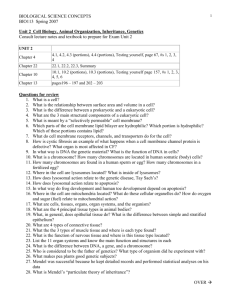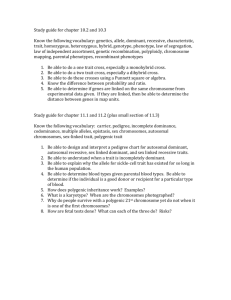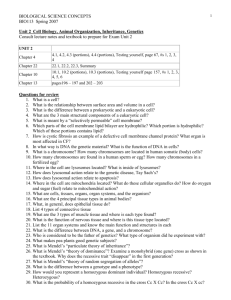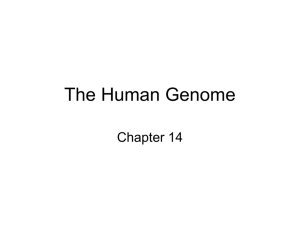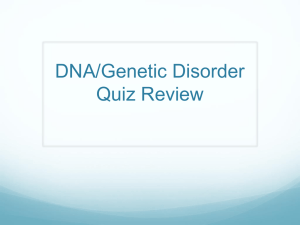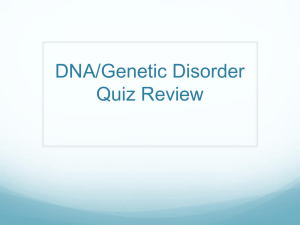Standard Assessment- Exam Key
advertisement
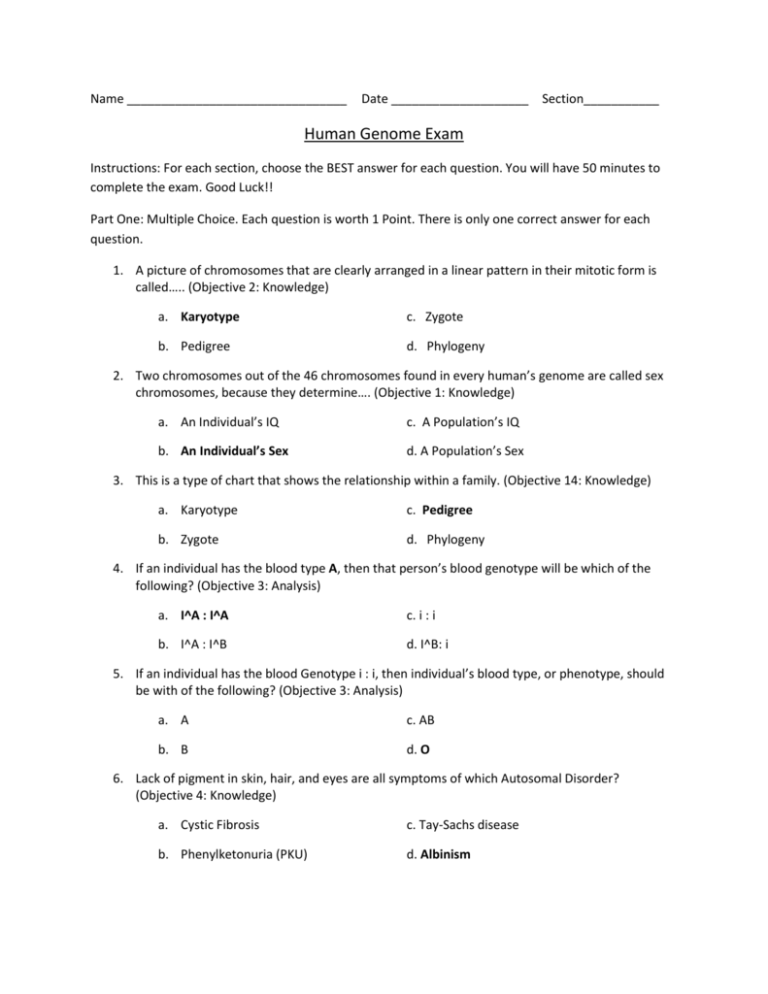
Name ________________________________ Date ____________________ Section___________ Human Genome Exam Instructions: For each section, choose the BEST answer for each question. You will have 50 minutes to complete the exam. Good Luck!! Part One: Multiple Choice. Each question is worth 1 Point. There is only one correct answer for each question. 1. A picture of chromosomes that are clearly arranged in a linear pattern in their mitotic form is called….. (Objective 2: Knowledge) a. Karyotype c. Zygote b. Pedigree d. Phylogeny 2. Two chromosomes out of the 46 chromosomes found in every human’s genome are called sex chromosomes, because they determine…. (Objective 1: Knowledge) a. An Individual’s IQ c. A Population’s IQ b. An Individual’s Sex d. A Population’s Sex 3. This is a type of chart that shows the relationship within a family. (Objective 14: Knowledge) a. Karyotype c. Pedigree b. Zygote d. Phylogeny 4. If an individual has the blood type A, then that person’s blood genotype will be which of the following? (Objective 3: Analysis) a. I^A : I^A c. i : i b. I^A : I^B d. I^B: i 5. If an individual has the blood Genotype i : i, then individual’s blood type, or phenotype, should be with of the following? (Objective 3: Analysis) a. A c. AB b. B d. O 6. Lack of pigment in skin, hair, and eyes are all symptoms of which Autosomal Disorder? (Objective 4: Knowledge) a. Cystic Fibrosis c. Tay-Sachs disease b. Phenylketonuria (PKU) d. Albinism 7. If a person had the Autosomal Disorder Galactosemia, which of the following symptoms would that person show? (Objective 4: Comprehension) a. Excess mucus in the lungs, digestive tract, and liver b. Accumulation of phenylalanine in tissues c. Accumulation of sugar in tissues d. Accumulation of lipids in brain cells 8. Billy has just been informed that he has Sickle Cell Disease. Sickle cell disease causes physical weakness and damage to all of the following organs except for….. (Objective 13: Application) a. The Brain c. The Liver b. The Heart d. The Spleen 9. If two chromosomes code for an individual's sex, the other 44 chromosomes are more commonly referred as… (Objective 1: Knowledge) a. Sex Chromosomes c. Blood Types b. Autosomes d. Pedigrees For Questions 10, 11, 12, and 13, use the picture to answer the four questions. 10. What is the chart shown above is a picture of? (Objective 14: Comprehension) a. A cladogram c. A Pedigree b. A Phylogentic Tree d. A Karyotype 11. Letter A is located next to a circle. What does a circle represent in this picture? (Objective 14: Comprehension) a. A female c. A child b. A male d. A hemophile 12. Letter D is represented by a shaded in box. What does a shaded-in shape represent in this chart? (Objective 14: Comprehension) a. A specific trait being observed b. A non-functioning trait c. A female d. The Parent Generation P1 13. What does Picture G represent? (Objective 14: Comprehension) a. A male carrying a specific trait b. A female carrying a specific trait c. A female not carrying a specific trait d. A male not carrying a specific trait Part 2: Short Answer Answer the following questions to the best of your knowledge. Your answers do not need to be in complete sentences. (2 Points Each) 14. From the chapter, pick two autosomal disorders and list their symptoms. (Objective 4: Knowledge) Disorder- Tay-Sachs Disease Symptoms- Lipid Accumulation in brain cells, mental deficiency, blindness Disorder- Cystic Fibrosis Symptoms- Excess Mucus in the Lungs, Digestive Tract, and Liver, Increased susceptibility to infections 15. Describe what the Human Genome Project was used for. (Objective 12: Knowledge) Used to analyze the human DNA sequence 16. Name a disease associated with….. (Objective 6: Knowledge) Chromosome 21- Lou Gehrig’s Disease, or Amyotrophic lateral sclerosis Chromosome 22- Neurofibrosis 17. What is non-disjunction? (Objective 8: Knowledge) When a homologous chromosome fails to separate, or “not coming apart.” Part 3: Essay Questions. Answer the following in complete sentences (3 Points Each). 18. What is DNA fingerprinting and how has it been used in society? (Objective 11: Application) DNA fingerprinting is a tool used to analyze sections of DNA that have little or no known function but vary widely from one individual to another. It has been used to help convict criminals as well as turn over many convictions. 19. What is Gene Therapy? (Objective 13: Knowledge) Gene Therapy is the process in which an absent or a non-functional gene is replaced by a normal, working gene. 20. Explain the impact of an inactivated X-chromosome in cats and which sex does it affect, male or female? (Objective 7: Knowledge) Cats have a gene that controls the color of coat spots. This gene is located on the X chromosome. If that X-Chromosome becomes inactive, a mixture of colors can show up in a cat’s fur. An inactivated X-chromosome affects females, since one X chromosome is switched on and off. Points Total: Multiple Choice: ________/ Out of 13 Points Short Answer: ________/Out of 8 Points Essay Portion: ________/ Out of 9 Points Total Points: ________/ Out of 30 Points



